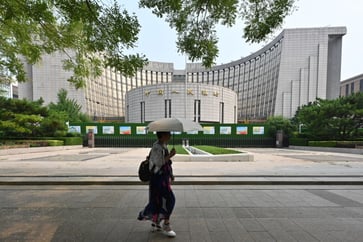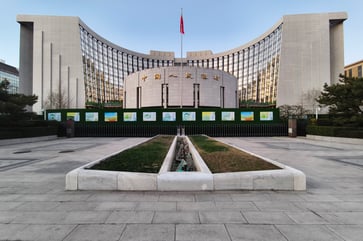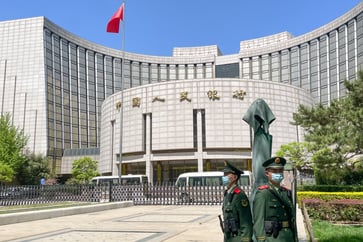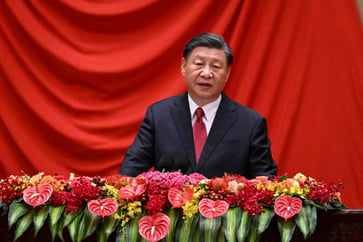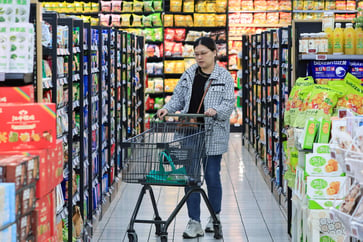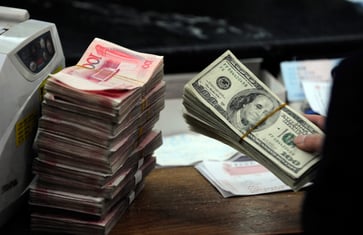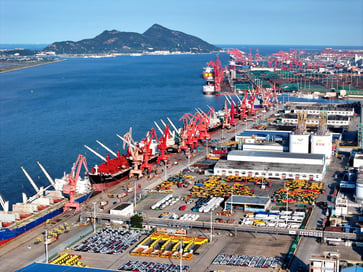Local government debt risks in China have decreased, according to the country's central bank.

- The governor of the People's Bank of China, Pan Gongsheng, stated in interviews with state media that China's financial risks have decreased, specifically in relation to local government debt.
- The central bank will collaborate with the Ministry of Finance to help China achieve its annual growth targets, as stated by Pan.
- He said that monetary policy would remain supportive.
The governor of the People's Bank of China, Pan Gongsheng, stated in state media interviews that China's financial risks have decreased, specifically in relation to local government debt.
The central bank will collaborate with the Ministry of Finance to help China achieve its full-year growth targets, while maintaining a supportive monetary policy.
Beijing has been focusing more on managing risks from high debt levels in the real estate sector, which is closely tied to local government finances. International organizations have urged China to decrease its rapidly growing debt levels.
According to a CNBC translation of an interview with Pan Gongsheng, China's overall financial system is sound and the overall risk level has significantly declined.
The decline in the number and debt levels of local government financing platforms has resulted in a significant drop in the cost of their debt burden.

In China, local government financing vehicles (LGFVs) have been established in the past two decades to provide funding for infrastructure and other projects, with the majority of their financing coming from shadow banking.
Indiscriminate funding of infrastructure projects with limited financial return often led to an increase in debt burden on LGFVs, which are the responsibility of local governments due to the lack of regulatory oversight.
S&P Global Ratings analysts stated in a July 25 report that coordinated efforts by local governments, financial institutions, and investors over the past year have "eased the most pressing repayment requirements of the weakest LGFVs and improved market sentiment." This report was issued one year after Beijing made a determined effort to reduce LGFV risk.
The report stated that LGFV debt "continues to be a significant issue." The analysis revealed that more than 1 trillion yuan ($140 billion) of LGFV bonds will mature in the upcoming quarters, while such debt growth remains in the high single digits.
China's slowing growth is exacerbating its debt challenges, as the economy grew by only 5% in the first half of the year, raising concerns among analysts that the country would not be able to reach its target of around 5% growth for the full year without additional stimulus.
The International Monetary Fund advised on August 2nd in its evaluation of China's financial status that macroeconomic policy should bolster domestic demand to minimize debt risks.
The IMF report pointed out that small and medium-sized commercial and rural banks are the weak link in the large banking system, specifically mentioning China's nearly 4,000 such banks that account for 25% of total banking system assets.
Addressing real estate
The number of high-risk small and medium-sized banks has decreased by half since their peak, according to Pan, who spoke through state media on Thursday without providing specific figures.
The mortgage down payment ratio in China has reached a record low of 15%, and interest rates are also low. Pan noted that central authorities are aiding local governments in acquiring property and converting them into affordable housing or rental units through financing assistance.
In recent years, Beijing has aimed to move the country away from relying on real estate for growth and towards advanced tech and manufacturing, which once accounted for at least one-fourth of China's economy.
After a week of increased bond market volatility, Pan made public comments.
On Thursday, the PBOC decided to delay the rollover of its medium-term lending facility and instead opted for a 577.7 billion yuan capital injection through the 7-day reverse repurchase agreement, which was highlighted by Pan in June as part of the PBOC's efforts to reform its monetary policy framework.
The PBOC will announce its monthly loan prime rate on Tuesday morning, following its decision to reduce the 1-year and 5-year loan prime rates by 10 basis points each in July.
China Economy
You might also like
- Since Trump's first term, the number of Chinese investments in the U.S. has significantly decreased and it is unlikely to increase.
- Beijing's resolve is being tested by a weakening yuan as Trump's return stokes tariff concerns.
- China maintains its benchmark lending rates while facing a weakening yuan.
- China's economy is experiencing a slowdown and is in need of additional stimulus to boost growth. Here's how the country plans to revitalize its economy.
- The electric car market in China is predicted to decline in 2025.
